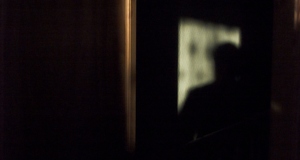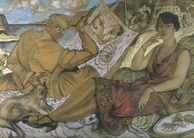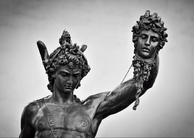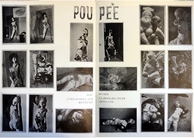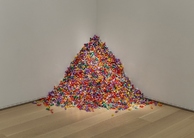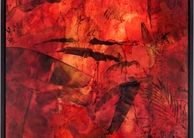From Discussions VOL. 4 NO. 1Art, Hallucination, and Embodiment
IN THIS ARTICLE
KEYWORDS
This essay will discuss visual perception as well as examine the relationship between art and hallucination. The paper is divided into three sections. The first section will explore phenomenological aspects of the Ayahuasca hallucinations described in Benny Shanon‟s book Antipodes of the Mind. In the second section, it will analyze certain aspects of abstract art. This art style will be used because it enables the viewer to form their own image from the constituent elements of the piece. With these two sections, the experience of hallucinations will be likened to viewing the world as an abstract art piece, and viewing abstract art will be likened to inducing a hallucinatory state. The third section explains a model that motivates this analogy by applying the theory of embodiment to a ven diagrammatic structure. Part One: HallucinationsAyahuasca is a psychedelic drug that induces visions as well as hallucinations in all other perceptual modalities1. The drug is created by combining parts from two plants: the vines of Banisteriopsis caapi and the leaves of Psychotria viridis2. The vine is cut, pounded, and then brewed along with the leaves, all in a ceremonial context, in order to create the Ayahuasca drink3. Shanon immersed himself in the culture of a South American tribe to gain knowledge about this practice. This drink is deeply rooted in this culture, being used for "for curing, for divination, as a diagnostic tool and a magical pipeline to the supernatural realm."4 Ayahuasca alters one‟s consciousness in many interesting ways. It confuses one‟s sense of self-agenthood, meaning one can no longer distinguish between one‟s own thoughts and those of other people. An individual is not sure whether (s)he actually owns his/her thoughts, or whether an external agent is forcing these thoughts. According to Shanon, it almost seems as if an external agent is implanting foreign thoughts into the mind of the person experiencing the hallucination.5 The identity of the participant is also affected. A person will identify with anything that (s)he looks at6. In essence, the person "becomes‟ the inspected object. There is no separation between the object present in the world and the person; the person understands their complete state of being in terms of the object that is perceived. For example, if a person were to inspect a hammer and hold it in his hand, that person would become the hammer and exist as the hammer; there would be no distinction between self and hammer. Not only does a person identify with an object, but the meaning of objects in the world changes. Mundane objects are understood to be part of a cosmic organization in which all parts play an intrinsic role7. In this way, "many phenomena pertaining to the Ayahuasca experience may be regarded as the products of affording the world an intense metaphoricity."8 The drinker takes the constituents of reality to mean something else; they may appear to be one thing, but they actually represent a deeper structure. Shanon references this to the platonic theory of essences when speaking about the underlying structure of objects in the world. It is as if one is actually viewing the essences of things through the window provided by the object in the world.9 While intoxicated, a person interprets the constituents of objective reality to be mere suggestions of what is truly there. The objects are taken as a metaphor for a deeper structure that is created by meanings attributed to a cosmic order. Mundane things in reality are recognized as a normal instance of a given object, but they somehow mean something different. Reality becomes less objective and more laden with the meaning derived from beliefs and intuitions. This in turn drives the hallucination; it drives the actual perceptual process of the drinker. For example, Shanon cites one instance of a man having a vision of Christ. Upon further questioning, the man admits that "what actually can be said about the vision is only the figure of a loving young man, clad in white and radiating light was seen."10 The viewer did not necessarily see a being with a label "Christ,‟ but rather saw a man fitting the description of Christ given by his religious history, and interpreted this man to be Christ. Shanon goes on to argue that any cognition is closely tied to the meaning one imparts on a scene, stating that "from a cognitive-psychological point of view, if the figure seen was identified as being Jesus, then phenomenologically this is indeed who was seen."11 His stance is that the meaning imparted on a scene will affect the actual perceptual experience. The reasoning behind this stance will be used later in the discussion of abstract art. The perceptual process of viewing abstract art is influenced by the meaning attributed to the scene at hand, and as such serves as a thread of similarity between art and hallucination. Consciousness often loses its unity after drinking the brew. A person can become dissociated from their body and observe their previous identity from an outside perspective.12 This can create recursive dissociation from identities, leading to an infinite regress of exiting the current identity and observing the previous identity from an outside perspective.13 The dissociation can also be on a perceptual level, leading to a split in the visual field. A drinker will sometimes see half of their visual field as a hallucination while the other half remains objective reality.14 While under the effects of the drug, it is difficult to differentiate psychological states. One is unsure whether one is "perceiving or remembering, whether one is perceiving or imagning, [or] whether one is thinking or perceiving the thoughts of others."15 The mode of thought becomes cloudy; the normal boundaries between observation and imagination are diluted and these distinctions seem to become irrelevant. One exists in terms of the surrounding environment; imaginings becomes reality and thoughts may not be one‟s own. This would seem to impact one‟s theory of mind, "the ability to represent the mental states of others."16 If one is unsure if thoughts are self-generated or those of another individual, then one may start to question the extent to which other people have minds that are creating thoughts distinct from one‟s own. This leads into the next aspect, that of individuation. Drinkers report a feeling of connectedness to all aspects of reality.17 It is as if they are integrated into a kind of supreme consciousness. The distinction between self and other is diminished by the realization that they and everyone else are part of a larger whole. This agrees with the theory of mind hypothesis by making the intentions and thoughts of others irrelevant because each person is considered to be connected to a sort of super consciousness, and it is this consciousness that governs existence. One is also said to gain knowledge of a supreme sort: knowledge of the "true‟ nature of reality. Also, the normal constituents of reality are seen as "more real than real.‟ Sensory perceptions are intensified, resulting in a different interpretation of the objects that exist in the world. Continuing along this same thread of individuality is the phenomenological report of varying senses of a coherent self. Participants often report losing their sense of self, or having only a slight remnant of their self.18 This varies with the experience of the drinker; novice drinkers often completely lose their sense of self, while more experienced drinkers are able to maintain a more coherent sense of self throughout the experience.19 This concludes the summary of the phenomenological effects of the drug Ayahuasca. The third section of this paper will deal with creating a model of perception that is able to account for how an individual is able to experience these things in terms of everyday cognition. However, it is first necessary to talk about abstract art viewing and relate this experience to hallucination.Continued on Next Page » Suggested Reading from Inquiries Journal
Inquiries Journal provides undergraduate and graduate students around the world a platform for the wide dissemination of academic work over a range of core disciplines. Representing the work of students from hundreds of institutions around the globe, Inquiries Journal's large database of academic articles is completely free. Learn more | Blog | Submit Latest in Visual Arts |










